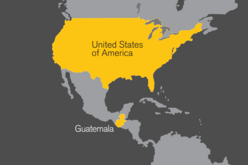No other escape: one girl’s courageous journey to freedom
Some 60,000 unaccompanied children from Central America crossed the United States border last summer, many fleeing violence and seeking reunion with a parent. This is one girl’s story.
Some 60,000 unaccompanied children from Central America crossed the United States border last summer, many fleeing violence and seeking reunion with a parent. This is one girl’s story.
Maria* has few memories of innocent childhood days. The 16 year old grew up in Guatemala, a country with one of the highest rates of violent crime in Latin America and a hub for human trafficking. When Maria was a child, her father was murdered by gang members and her mother, Ana, moved to the United States to try to build a new life. She left Maria in the care of a relative until she could send for her.
But that relative sold Maria to a man who repeatedly raped her, even as she begged him to stop. The man and Maria’s relative both threatened to kill her if she ever told anyone about the abuse.
After years of maltreatment, Maria could endure no more. She had to get to the U.S. and find her mother—there was no other escape.

Maria put herself in the hands of a coyote, a smuggler who would arrange her trip north. The journey by bus though Guatemala and Mexico took more than six weeks and was full of dangers Maria would rather put behind her than recall.
When Maria stepped off the bus for the last time, she still faced a three-hour trek through the desert to the Pecos River. On the other side of the river was Texas.
Maria crossed the Pecos on a raft. Exhausted as she was, she knew she had to push on when she reached the far bank. She walked and ran in turns through scrubland for nearly two hours until U.S. Homeland Security officials stopped her.
But—finally—she was in America. The coyote had stolen the money she had left after paying for the trip, but she had the most essential thing: hope.
Maria told the U.S. authorities what had happened to her in Guatemala, explaining that she was trying to reach her mother, now living in Florida. They placed her in a shelter with other children who had been detained crossing the border, but who now faced deportation.
While Maria waited for a hearing with an immigration judge who would decide her fate, a caseworker at the shelter took the first steps to bring Maria and her mother together.
The caseworker was able to contact Ana in Miami and obtained the documentation needed to prove her relationship with Maria and start the reunification process. Then the caseworker put in a call to the International Rescue Committee in Miami, one of several cities where the IRC is helping young people like Maria restart their lives.
IRC caseworkers visited Ana in her home, where they talked with her about the support Maria would need, both financial and emotional. They asked her if she was ready for her daughter to join her.
Yes, Ana said, she was ready. It had been six years since she’d held her daughter in her arms.
The IRC team explained to Ana that she and Maria would have help. They would make sure Maria was enrolled in school, had medical care and legal support, and could access the specialized services she would need as a survivor of abuse and trafficking.
When Ana met Maria at the Miami airport, she saw that her little girl had become a young woman—a very courageous young woman. For her part, Maria vows to move beyond the traumatic experiences that drove her to make the dangerous journey from Guatemala to the U.S. “I don’t want that situation to define me,” she says.
The IRC has put Maria in touch with a legal team that is helping her make the case to the immigration authorities that she should remain in the U.S. with her mother.
For now, Maria says, “I am happy to be in a country where I feel safe—where I will have opportunities to live a better life.”
*Names have been changed to protect the family’s privacy.